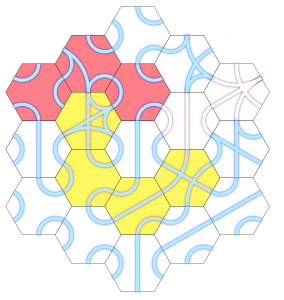I found this to be a really interesting reading. I have never played past the tutorial level in the NES mario game, and so for me the tutorial level has been the whole experience. It is so well crafted that I didn’t realise it was a tutorial at all. Anna Anthropy carefully dissects the anatomy of the level. The sheer depth of the design is incredible. The thing that caught me the most was the jump – giving the player a harder but nonfatal/unstaked challenge to practice on, and then following up with a jump over real gap that is almost visually identical (and would probably be to someone playing for the first time) but slightly easier than the just seen practice. It made me think to games I’ve played they have had possibly similar set ups. I feel Kirby’s Adventure had this, although probably with less agonised over level design. In Kirby’s Adventure, the various levels of “hidden” shortcuts makes the player feel clever for working out the various environmental effects of the abilities they can gain from the enemies, and this is then necessary in the far more nonlinear later levels.
Author: atiwari1
Homeplay: Overcooked
Overcooked is a 1-4 player co-op game in which you control a team of chefs to collaboratively assemble food in a frantic setting. The single-player campaign seems sad and lonely, so it’s really more of a 2-4 player game.
In my play-through of it, I played it with my friend Clelia from start to the end of World 3. The control system was very intuitive and easy to grasp, and the game itself is easy to understand and begin to play. The challenge and the fun in it is the deluge of tasks that you have to work together to have any hope of fulfilling in time. The mechanics that really worked for us were the adrenaline/stress of having to jump around and continually organise ourselves spatially. The surprising number of interactions and ways to cook/organise in the game were enjoyable too and it didn’t feel like there were artificial barriers to increase difficulty or create stress — apart from the levels. From the start the co-op experience is extremely fun, high-strung and stress-filled. It keeps you filled with adrenaline but is really well punctuated by relief at having completed a level. The levels mostly lend themselves well to quickly thought up strategy expressed through swearing and shouting and are fun to play, even if you end up doing terrible on the first run.
Some of the levels had gimmicky design that I felt more as a random annoyance or busywork taking me out of stress-fun-zone than being a natural ramping up of difficulty. However, Clelia feels that she “enjoyed the levels that [I felt were more gimmicky], although they might not stand up to repeated playthroughs”, but also that “the logic of the game is less visible when there are those barriers, which can turn the fun spatial movement into just running around for no reason”. We also liked the first level being a tutorial without it actually saying THIS IS THE TUTORIAL.
I didn’t really get the scoring and it seemed to vary somewhat arbitrarily over the levels. Overall (neglecting the scoring), the difficulty of the levels seemed to be well set — e.g, it’s mostly possible to scrape or come just below a 1 star (the amount needed to pass a level) on the first try, on the subsequent tries if you plan and strategise during the inter-level wait it’s easily possible to do far better and get a 2 star, and to get the best rating requires practice and high-strung organisation to not make a single mistake.
Overall the co-op experience was really, really fun and energetic, and the difficulty and core mechanics of the game are well thought out. The graphics are very cute and the interactions are really well fleshed out, and there’s a ton of visual and gameplay variety to the levels (sans the gimmicks). The single-player seemed kinda boring from the very little I played of it, and some of the levels seem to have annoying mechanics that feel like artificial difficulty barriers rather than well thought out design, but the rest of the game-play still makes up for it.
Here is a video of someone else playing it:
Context & Reception
The developers are British, but there isn’t really a way to tell that from the game. The publishers are the same ones as the Worms series, so it’s really good to see that someone is keeping the local couch co-op torch lit. The critical reception seems overwhelming positive for the co-op aspect of it, and most people seem to enjoy the levels and the gimmicky aspects of some of them. The single-player seems mostly panned, and the developers themselves say that the first and foremost wanted to make a co-op game. It’s really sad that games having local co-op are rare now.
Mindmap


Mindmap is a game of playing thoughts in a brain. At each turn, players move their pieces in the hope for collecting Ideas. Just like someone’s mind, the board is continually changed by the Thought’s actions. As players move over the board, they collect Moods tiles, acting as stats used to resolve mental distraction (standoffs) caused by too many thoughts in one place.
A video of a full playthrough is available at: https://youtu.be/J66cCBx7I9E . The video is slightly different from the rules in that the mood dial is randomly spun at each confrontation rather than being incrementing by one after each round, a change we found to increase strategy in moving and placing your pieces and removing randomness.
The full rules are available at https://docs.google.com/a/andrew.cmu.edu/document/d/1nwtaT1s_dI06V9UBQB2tmVqEYb8xJo62vM4Km-10uYY/edit?usp=sharing
Our changes over iterations included removing minigames and instead adding tactics to tile placement, changing the board tiles from rectangular to hexagonal and theming the game first as rescuing a “drunk” target piece from the board, to thinking up ideas for elon musk, to competing to collect a number of ideas on a board that fluidly changes over time.
7 Micro Games — Aman Tiwari
- (≥1 players)
imagine the walls of the room as an atlas. choose a great circle, and describe the climates, cultures, flora and fauna of the regions as you trace over it. - (≥1 players)
spin google maps, flip through an atlas at random, choose a place without looking. look at it, compete to find a thing (object, shape, stain) in the room that most closely matches the shape of the country (or state) (alt ruleset: choose a place without showing it to the others. the ‘chooser’ can point at objects in the room to get the others to guess the country chosen.) - (≥2 players, must be cloudy)
the game starts when a player declares it to start and another agrees with the declaration. it must be cloudy. the game lasts for the next 30 minutes (adjust based on skill). if the clouds clear within the next 30 minutes, the declarer wins. - (≥3 players)
a person says a word. on the count of 3, the others say a word after it (after defined lexicographically/as in the dictionary). the closest word wins. if two people say the same word they automatically lose, and if someone says a non-real word (and is found out) they also lose. - (≥4 players)
everyone is divided into 2 teams. they line up, alternating by team (beginning with team 1). then, leftmost person makes a statement about the scene in front of them. the information is passed left to right, by whispering from person to person. a player can change one word when re-transmitting the statement. the goal of team 1 is to have the end person say a statement with the same semantic meaning, and of team 2 to prevent that. - (≥2 players)
the ceiling is beautiful. race from an end of a room (with a beautiful ceiling) to the other, only looking at the ceiling - (≥2 players, have to be in thrift/junk store)
pictionary, but instead of drawing you can only use objects found in the thrift/junk store you are all in.
Aman Tiwari
This is an image of myself (pre-haircut):

My twitter : @aman_gif
My tumblr: http://we-jelly.tumblr.com
My website (un-updated… 🙁 ) : http://aman.work
My top-5 emojis: 😮☺️👁⬛️😤
I’m excited for this class and to make things for it. I also have never really collaborated with people before, so that will be interesting.
